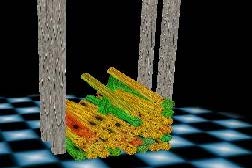Scientific Articles, Reports & Theses
List of Publications
Select tag “Algoryx” for publications affiliated with Algoryx, or “External” for external publications that use or cite Algoryx software.
2003 |
|
 | : Splitting methods for dry frictional contact problems in rigid multibody systems: Preliminary performance results. In: The Annual SIGRAD Conference. Special Theme-Real-Time Simulations. Conference Proceedings from SIGRAD2003, pp. 11–16, Linköping University Electronic Press 2003. |
